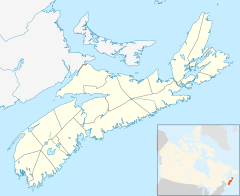Framboise River facts for kids
Quick facts for kids Framboise River |
|
|---|---|
| Country | Canada |
| Province | Nova Scotia |
| County | Richmond |
| Physical characteristics | |
| River mouth | 45°42′08″N 60°19′56″W / 45.702351°N 60.332088°W |
The Framboise River is a special kind of river in Cape Breton Island, Nova Scotia, Canada. It's an "estuarine river," which means it's a mix of fresh water from the land and salty water from the ocean. It flows into the Atlantic Ocean.
Contents
River's Journey
The Framboise River starts as an estuary. An estuary is where a river meets the sea. This one stretches from Seal Rocks and Framboise Cove on the coast. It goes northwest to where three other rivers meet it. These rivers are Bagnells River (also called Bagnells Lake), Middle River Framboise, and Northeast Framboise River.
Smaller Streams Joining In
Two smaller streams, Strachans Brook and Mary Anns Brook, also flow into the estuary from the south. The river's mouth, where it empties into the ocean, is located at 45°42′08″N 60°19′56″W / 45.702351°N 60.332088°W.
Where is Framboise?
The small community of Framboise, Nova Scotia, is located to the southwest of the river. The name "Framboise" means "raspberry" in French. It was probably given this name by early settlers because of the many raspberries in the area.
River's Surroundings
The land around the Framboise River is called its watershed. A watershed is all the land where water drains into a particular river or lake.
Lakes in the Watershed
Two important lakes in this area are MacArthurs Lake and MacMullin Lake. These two lakes are connected by a small channel. MacArthurs Lake has been described as "a beautiful pond." It is located at 45°47′16″N 60°18′10″W / 45.787801°N 60.302678°W. This lake sits about 31 meters (102 feet) above sea level.
Middle-River Framboise Wilderness Area
A large protected area called the Middle-River Framboise Wilderness Area is also part of this watershed. It covers about 5,640 hectares (13,940 acres). This area is mostly wetlands, streams, lakes, and forested hills called drumlins. Drumlin are long, oval hills made of glacial deposits. This wilderness area is a bit hard to reach, which helps protect its natural beauty.
A Look at Mining History
Back in the 1890s, a special type of rock called ore was found in Strachans Brook. This ore contained valuable metals like zinc (9.55%), lead (2.28%), and copper (0.94%).
The Stirling Mine
A company called British Metals Corporation bought this mine, known as the Stirling base metal deposit or Mindamar Mine. They operated the mine from 1935 to 1938. During this time, waste materials and metals that weren't recovered were released directly into the brook. The mine was opened again from 1952 to 1956. This time, the waste was stored in a special area called a tailings pond. A tailings pond is like a big basin designed to hold mining waste safely.
Strachans Brook's Flow
Strachans Brook flows slowly eastward for about 8 kilometers (5 miles). It passes through swampy areas before joining the Framboise River estuary. This meeting point is about 4 kilometers (2.5 miles) from the coast. There's a small fan-shaped landform, called a deltaic fan, where the brook enters the estuary. Scientists have studied the area to see if the water and sediments in the Framboise River were affected by the old mining waste.


